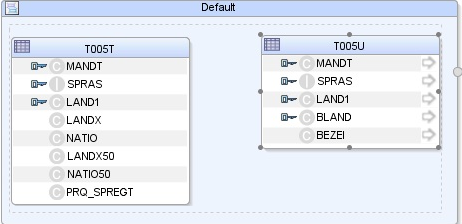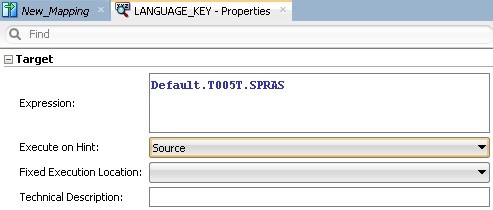Creating the Mapping
Now that the source and target data models are created, it is possible to create a mapping to integrate data from the T005T and T005U SAP tables to the WS_GEO_DS Oracle table.
To create the mapping, perform the following steps:
Create the Mapping
-
Open Designer.
-
In the Projects tree view, expand the
SAP DemoProject. -
Expand the
SDE_SAP_GeoDimensionfolder. -
Select the Mappings node.
-
Right-click and select New Mapping.
-
In the Mapping Definition tab, enter the mapping name:
SDE_SAP_GeoDimension.W_GEO_DS. -
Save the mapping.
Define the Source and Target Datastores
To define the source and target datastores:
-
In the Models tree view, select the
WS_GEO_DSdatastore from theOracle TargetModel. -
Drag this datastore into the Target Datastore area of the Logical diagram. (Right area of the Logical diagram)
-
In the Models tree view, select the
T005T Country Namesdatastore from theSAP ERP Sourcemodel. -
Drag this datastore into the
Sourcesarea of the Logical diagram. -
Perform the same operation for the
T005U Taxes: Region Keydatastore from theSAP ERP Sourcemodel. The Sources area of the Logical diagram should look as shown below:
Define Joins between Sources
To create joins between the source datastores of a mapping:
-
In the Sources area of the Logical diagram drag the SPRAS attribute from the
T005T Country Namedatastore onto theSPRASattribute in theT005U Taxes: Region Keydatastore. -
On the Create Lookup or Join popup, select Join and click OK. This defines the first join on the Language Key identifier, as shown below:
-
Drag the
LAND1attribute from theT005T Country Namedatastore onto theLAND1attribute in theT005U Taxes: Region Keydatastore. The join is extended with the new attributes. In the Properties panel, you can see the join clause:T005T.SPRAS=T005U.SPRAS AND T005T.LAND1=T005U.LAND1 -
In the Properties panel, select Generate ANSI Syntax and Join Order options, and make sure that the Execute on Hint option is set to Source as shown below:
-
Make sure that table number of
T005Uis smaller than that ofT005T. In 1:n relationships the parent table has to be the first in a join.
Create the Mappings
To create the mappings of the target datastore:
-
Select the
LANGUAGE KEYattribute from the target datastore. -
Drag the
SPRASattribute from theT005T Country Namessource datastore onto the LANGUAGE KEY attribute of the target datastore. -
Make sure that the Execution on Hint option is set to Source. The mapping should look as shown below:
-
Repeat this operation to perform the following simple mappings:
-
W_GEO_DS.COUNTRY = T005T.LAND1 -
W_GEO_DS.COUNTY = T005T.LANDX -
W_GEO_DS.STATE_PROV = T005U.BLAND -
W_GEO_DS.NATIONALITY = T005T.NATIO
Define the Mapping Flow
To define the mapping flow:
-
Select the Logical diagram. The Flow diagram looks as shown below;
-
In the target group, select the access point for the source group that contains both the
T005TandT005Udatastores. This source group represents the source dataset made up of two joined SAP ERP datastores. -
In the Property panel, under Loading Knowledge Module, select
LKM SAP ERP to Oracle (SQLLDR)orLKM SAP ERP to SQLfrom the Loading Knowledge Module drop-down list.-
If you are using FTP for the data transfer, please set the FTP_TRANSFER_METHOD option to
FTP. If the FTP server is installed on your ODI agent machine, selectNONE. -
Leave other options as they are.
-
-
In the target group, select the target Oracle database, which is also used as the staging area for this mapping.
-
In Property panel, under Integration Knowledge Module, select
IKM Oracle Incremental Updatefrom the Integration Knowledge Module drop-down list. -
Set the IKM options as follows:
-
Select
Nofor the FLOW_CONTROL option. -
Leave other options as they are.
-
-
From the File menu, click Save and close your mapping.




